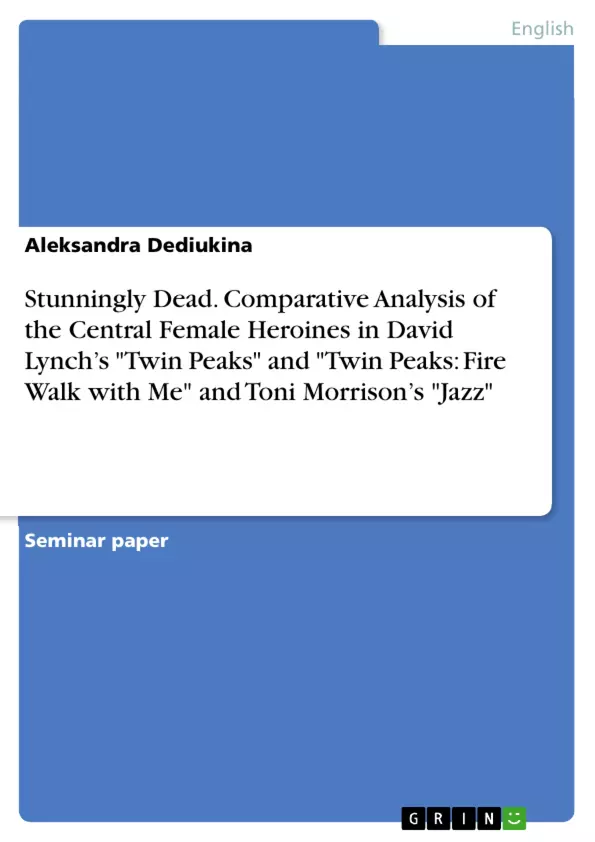This term paper compares two texts — the television series “Twin Peaks” by Mark Frost and David Lynch (released in 1990–1991) taken together as a whole with Lynch’s following prequel “Twin Peaks: Fire Walk with Me” (1992) and the novel Jazz (1992) by Toni Morrison — through the prism of two theoretical findings of German cultural critic Elisabeth Bronfen.
First, this is her concept of ‘crossmappings’, formulated and applied as a method of analysis in the book Crossmapping. Essays zur visuellen Kultur (2011). Second, this is her theory regarding the depiction of a dead female body in arts that, seemingly counter-intuitively, is a highly widespread artistic image to which the perceiver responds rather with fascination than with terror. This idea was represented and comprehensively described in the earlier book Over her Dead Body (Bronfen 1992), whose central subject is the connection between death, femininity, and artistic representation.
Inhaltsverzeichnis (Table of Contents)
- Introduction
- Crossmapping: Unexpected Juxtaposition
- Her Last Dance
- "Tonight is the night that I die. <...>. But if I die he can't hurt me anymore."
- "He's coming for me. Maybe tonight. Maybe here."
- Conclusion
Zielsetzung und Themenschwerpunkte (Objectives and Key Themes)
This term paper aims to compare the television series "Twin Peaks" by Mark Frost and David Lynch (released in 1990-1991) and its prequel "Twin Peaks: Fire Walk with Me" (1992) to the novel Jazz (1992) by Toni Morrison, employing the theoretical framework of Elisabeth Bronfen. The paper analyzes these texts through the lens of Bronfen's concept of "crossmappings" and her theory on the depiction of dead female bodies in art. The analysis focuses on the central female heroines in each text, exploring the themes of female agency, objectification, and the potential for self-worth within these narratives.
- Crossmappings as a method to uncover shared thematic concerns between seemingly distinct texts.
- The aestheticization of dead female bodies in artistic representations and its cultural implications.
- The portrayal of female characters and their agency in the context of societal expectations and power dynamics.
- The exploration of the potential for self-worth and its vulnerability in the face of external pressures and societal constraints.
- The examination of the narrative strategies employed by Lynch and Morrison to depict the experiences of their female protagonists.
Zusammenfassung der Kapitel (Chapter Summaries)
The first chapter, "Crossmapping: Unexpected Juxtaposition," introduces the theoretical framework of the paper, discussing Bronfen's concept of "crossmappings" and its application to the comparison of "Twin Peaks" and "Jazz." The chapter emphasizes the socio-cultural significance of these crossmappings, highlighting how they reflect broader societal concerns and anxieties.
The second chapter delves into the analysis of the chosen texts, focusing on the similarities and differences between the two narratives. The chapter explores the shared plot patterns, particularly the murders of Laura Palmer in "Twin Peaks" and Dorcas in "Jazz," and how these events highlight the themes of female agency, objectification, and the potential for self-worth within these narratives.
Schlüsselwörter (Keywords)
The main keywords and focus topics of the paper include: crossmappings, aestheticization of death, female agency, objectification, self-worth, cultural anxieties, narrative strategies, "Twin Peaks," "Twin Peaks: Fire Walk with Me," Jazz, Elisabeth Bronfen, and Toni Morrison.
- Arbeit zitieren
- Aleksandra Dediukina (Autor:in), 2024, Stunningly Dead. Comparative Analysis of the Central Female Heroines in David Lynch’s "Twin Peaks" and "Twin Peaks: Fire Walk with Me" and Toni Morrison’s "Jazz", München, GRIN Verlag, https://www.hausarbeiten.de/document/1502955


